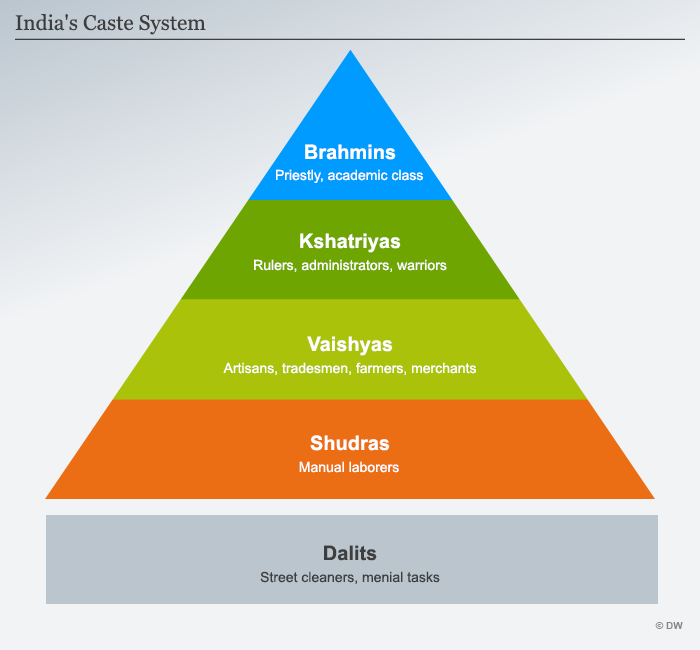(Relevant for sociology paper-2,caste)
Sociologists use the term social stratification to describe the system of social standing. Social stratification refers to a society’s categorization of its people into rankings based on factors like wealth, income, education, family background, and power.
In india caste is closed social stratification system

The caste in India is divided into four different referents discussed as below:
- Caste as varna:
There are four varnas in India. They can be said to be categories. These include; Brahmans or priests, Kshattriyas or warriors, vaishyas men of commerce and Sudras who are workmen. They are not comprehensive since there is also a majority of population which do not fall in any of the above four categories. The classification of castes into varnas provides an indicator to make claim to higher status or as an analogy to find the actual relations.
- Caste categories:
These are those populations which carry the same linguistic background, same traditional occupation and at times same caste names. These are exhaustive as well as exclusive as it covers whole of the population and at the same time no two people can fall under two categories making it exclusive.
- Caste associations:
Caste associations are groups, exclusive but not exhaustive which has come into limelight in the recent century. They are not exhaustive in that they have developed unequally, being strong in Gujarat, Kerala, and Bengal and less strong elsewhere.
- Caste as jati:
This is the most important of the overall four referents. This can be explained by an overlook on the traditional Indian society. The society was divided into smaller blocks which could be arranged and rearranged as per advantage. Each block itself constituted a caste system. And each block consisted of an entire population of a village which was stratified into a single caste. This caste system, therefore, meets all the criteria.
Activities characteristics of the caste system are of three kinds:
- First, come those activities which distinguish each caste from one another. It has a distinct name, it might have distinct beliefs about its origin, and it probably will show different elements in ritual, particularly in life-crisis rituals. These and other attributes serve to mark off one caste from another.
- The second activity is concerned with interdependence or the existence of a system. The second activity lies in two solid principles. The first is division of labor and the second is, that castes form a system because each caste has differential access to political power.
- The third activity is an aspect of the hierarchy.
Caste as rigid social stratification :
This definition is simple and easy to understand. It explains linking caste with other form of social stratification and differentiating them through other social mobility. This definition points out two facts that are a. rank is ascribed at birth, b. the change of rank is impossible. Here the question may arise:
- Whether this system is followed in Indian caste system and
- Whether rigidity is sufficient for defining caste system.
- Ascription of rank by birth in Indian caste system means that one must be born of the parents of the same caste. There are various forms of marrying across caste, both institutionalized and irregular, which might suggest the question of rigidity as asked above.
- The next is the question of whether rigidity provides sufficient criterion to distinguish caste from other forms of social stratification or not?
If we ignore the fact of inter strata mobility and discuss on the basis of clear rank ascription then can be said that the caste system is also found in South Africa and parts of America on the base of skin color. Are these, then, also caste systems? No, is taken as an answer by the Indianists. In absence of clear color badges of rank ascription, India caste will be impaired on the basis of spatial mobility and diversification of social relations. That is on the basis of the jati system.
Caste is defined through religion:
The discussion here is that the caste system is distinguished from other forms of social stratification because it is related to religious beliefs. In absence of such religious beliefs, other social stratification may exist.
This view is clearly explained by Dumont and Pocock. This can be explained by the following quotations.
[1] in the caste system we have to do pre-eminently with religious ideas connected with purity.
[2] the caste system can only be understood when we realize that it is permeated by essentially religious conceptions and further that these religious conceptions are based upon a social apprehension of the pure and the impure.
[3] in order to understand the distribution of occupations in India we have to go to beliefs of a religious nature.
[4] it is above all religious ideas rather than economic values which establish the rank of each group.
In order to understand these statements we first need to know whether these statements are analytic or synthetic. If they are analytic, then the predicate is contained within the subject, and the statement is in fact an invitation to agree upon pollution beliefs as the meaning of the word ‘caste’. If they are synthetic then subject and predicate are separate elements, hypothetically connected into a system. The distinction is necessary because if these were analytic then these will be considered to be axiom and cannot be proved wrong. If it is synthetic then it puts forward an empirically testable connection.
If we consider the fourth quotation to be synthetic then it is to be tested that rank is established by attribute of purity and not by control over economic sources. Which means change in economic resources can take place without causing changes in rank. This is partially true it can work for the Brahmans and the untouchables but not for the middle ranks. So we consider all the above four statements to be analytic.
Our object of study was a closed system of stratification, which we define as a structure of relationships of a specific kind, and not as a system of beliefs or values. What is the justification for doing this?
- Though the purity impurity formula provides a base for opposition, distinction and hierarchy it is not the only formula that does so.
- One can either explore the difference between, to follow the example, Swat stratification and Indian stratification or ask to what extent different beliefs are connected to differences social relations.
- Or we can further breakdown the system of closed stratification and see what are the things social relations are entailed by.
Therefore, it is not to say definition by religion is wrong, it has it own uses and its own hindrances.
Structural definition of caste:
The method of presentation will be to take Nadel’s criteria of social stratification —exclusive and exhaustive groups ranked in a system—and ask what structural features need to be present in addition to for the system to be considered closed.
- The first criterion that comes into mind is the recruitment criterion that is a man is born into a caste and there is no alternative to joining a caste. The same facts can be stated through negations of activities that are for example, status is immutable, individual mobility is not allowed, or, kinship relations are restricted within the caste.
- Leach, comparing caste and class says that every individual caste has specific economic rights, responsibilities and duties. not), and, secondly, that in aclass systemthe underprivileged majority compete for the favors of an elite minority, while in a caste system the positions are reversed, an elite majority competing for the services of a minority, who therefore have security.
- The fact that every caste has individual economic rights and duties is useful and therefore it forbids competition between castes. The absence of competition between castes is connected with the direction of economic and political relationships. All castes are political groups so far rituals are concerned but only the dominant caste has political existence, not as a corporate political group, for political competition.
- Barth has stated one characteristic of caste as summation of roles. Can it be an analytical statement to that affect that caste system cannot be conceived without summation of roles? In the present field of discourse the absence of summation of roles would mean there are, two or more status frameworks to some extent separated from one another.
- So far from the above discussions it can be said that that caste systems can only exist in small-scale societies, since the system depends on ready recognition of status, since there are no obvious and immutable recognition signs, and since a man therefore needs to carry in his head or to be able to ascertain easily the status of the people with whom he is interacting.
- To sum the above the following is offered as definition of structured system of caste. system : For a given society to exhibit a caste it must be divided into groups,
- Which are sole and absolute,
- Exhaustive
- Ranked
- Closed (recruitment is by birth only)
- Relations are organized by summation of roles
- Which cooperate and do not compete.
Caste in modern India
The structural definition clears out many confusions about the caste system in India. In place of small countless, isolated, political divisions there are emerging various large political arenas known as the State of Indian Union. Within these states, various jatis which were separated by political divisions are now uniting.
The change is clearest where caste associations have emerged. These associations have three fields of activity.
- they are concerned with ritual respectability
- The associations concerned with welfare, and education, and finding jobs for their members
- Such activities involve competition with other castes, so that associations become involved in politics.
To conclude, it seems worthwhile asking more to what extent groups can still plausibly operate within a caste system (a) at the village level and (b) at the state level.
- The structural criteria still hold at the village level but the other does not. Nowadays people have economic and political relationships beyond that boundary. By this route castes which are ritually or politically low in the village may become rich. In another world now there is no need for a summation of roles.
- The same description at a larger level fits the state. Caste associations are not strata in the strict sense, which means everyone belongs to such associations.
In conclusion, we may say the new caste associations ‘castes’ in a loose way but they are definitely not operating in a caste system.
.
Follow us :




One comment